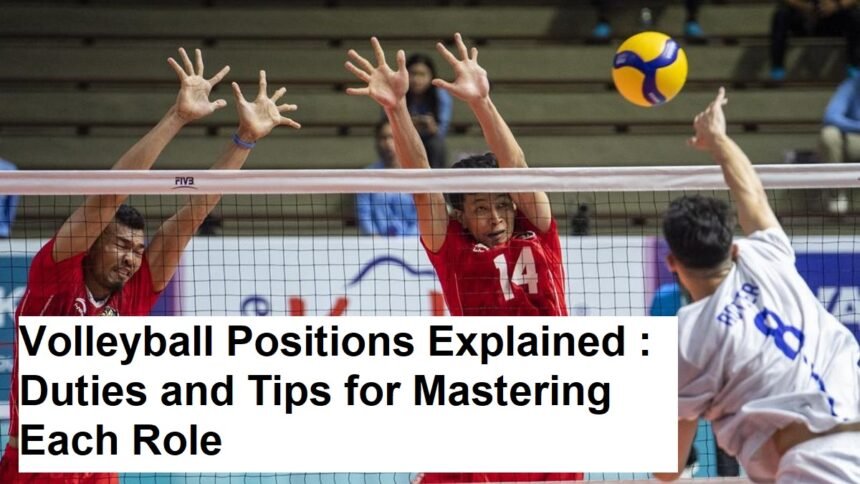Introduction
Volleyball is a dynamic and fast-paced sport that requires teamwork, strategy, and a clear understanding of player roles. Each position on the court has unique responsibilities, and mastering these roles is essential for both players and enthusiasts who want to improve their game. In this article, we’ll explain the different volleyball positions, their tasks, and some helpful tips on how to learn them effectively.
1. Setter
Role and Responsibilities:
The setter is often considered the playmaker or the quarterback of the volleyball team. Their primary job is to deliver accurate sets to attackers, enabling them to score points. The setter must have excellent hand skills, quick decision-making, and the ability to read the game. They often touch the ball more than anyone else on the court and need to coordinate the team’s offensive plays.
Tips to Learn:
- Practice precise hand touches and footwork.
- Watch professional setters to understand their movement and decision-making.
- Improve your communication skills to coordinate effectively with teammates.
- Play in different game scenarios to gain experience in setting under pressure.
2. Outside Hitter (Left Side Hitter)
Role and Responsibilities:
Outside hitters are versatile players responsible for attacking, passing, and playing defense. They often receive the serve and are key attackers during offensive plays. They need to be strong, quick, and reliable, with good passing skills for receive formation.
Tips to Learn:
- Develop strong spiking and passing techniques.
- Practice receiving serves from various angles and speeds.
- Work on your jumping ability to improve attack power.
- Focus on balance and footwork for better positioning.
3. Opposite Hitter (Right Side Hitter)
Role and Responsibilities:
The opposite hitter plays on the right side of the court, usually also involved in attacking and blocking. They often hit from the back row and are responsible for blocking the opponent’s outside hitter. Their role is crucial for both offense and defense.
Tips to Learn:
- Practice attacking from the right side to become comfortable with different angles.
- Strengthen your blocking skills for effective net defense.
- Improve your back-row skills for attacks and defensive plays.
- Develop a balanced approach to attacking and blocking.
4. Middle Blocker (Middle Hitter)
Role and Responsibilities:
The middle blocker specializes in blocking opposing attacks and executing quick middle attacks. They are usually tall and have excellent jumping ability. They need to read the opponent’s setter and anticipate attacks.
Tips to Learn:
- Improve your timing for blocks and quick middle attacks.
- Practice quick footwork to move swiftly along the net.
- Study opponents’ attacking patterns for better anticipation.
- Work on blocking techniques to cover more space.
5. Libero
Role and Responsibilities:
The libero is a defensive specialist who focuses on passing and receiving serves. They wear a different color jersey and cannot attack above the net or serve in most competitions. Their main task is to provide accurate passing to set up offense.
Tips to Learn:
- Develop excellent digging and passing skills.
- Focus on reaction time and agility.
- Practice reading the opponent’s serves and attacks.
- Enhance your movement and positioning to cover the court effectively.
6. Defensive Specialist
Role and Responsibilities:
Similar to the libero, the defensive specialist primarily focuses on reception, digging, and defense. They often come into play when the team needs extra help with passing or receiving.
Tips to Learn:
- Work on agility drills to improve court coverage.
- Practice passing under various conditions.
- Study opponents’ attack patterns for better anticipation.
- Keep a calm mindset and quick reflexes.
Tips for Learning Volleyball Positions:
- Start with Basics: Understand fundamental skills such as passing, setting, attacking, and serving.
- Watch and Learn: Observe professional matches and analyze player movements.
- Practice Regularly: Consistent practice helps improve coordination and understanding of roles.
- Play Different Positions: Try playing in various roles to understand their specific demands.
- Communicate: Effective communication with teammates enhances team coordination.
- Get Coaching: Seek guidance from experienced coaches to correct techniques and develop strategies.
Conclusion
Each volleyball position plays a vital role in the success of the team. By understanding the responsibilities of each role—setter, outside hitter, opposite hitter, middle blocker, libero, and defensive specialist—you can improve your gameplay and become a better team player. Whether you’re a beginner learning the basics or an advanced player aiming to refine your skills, focusing on these tasks and tips will guide you toward volleyball excellence.












